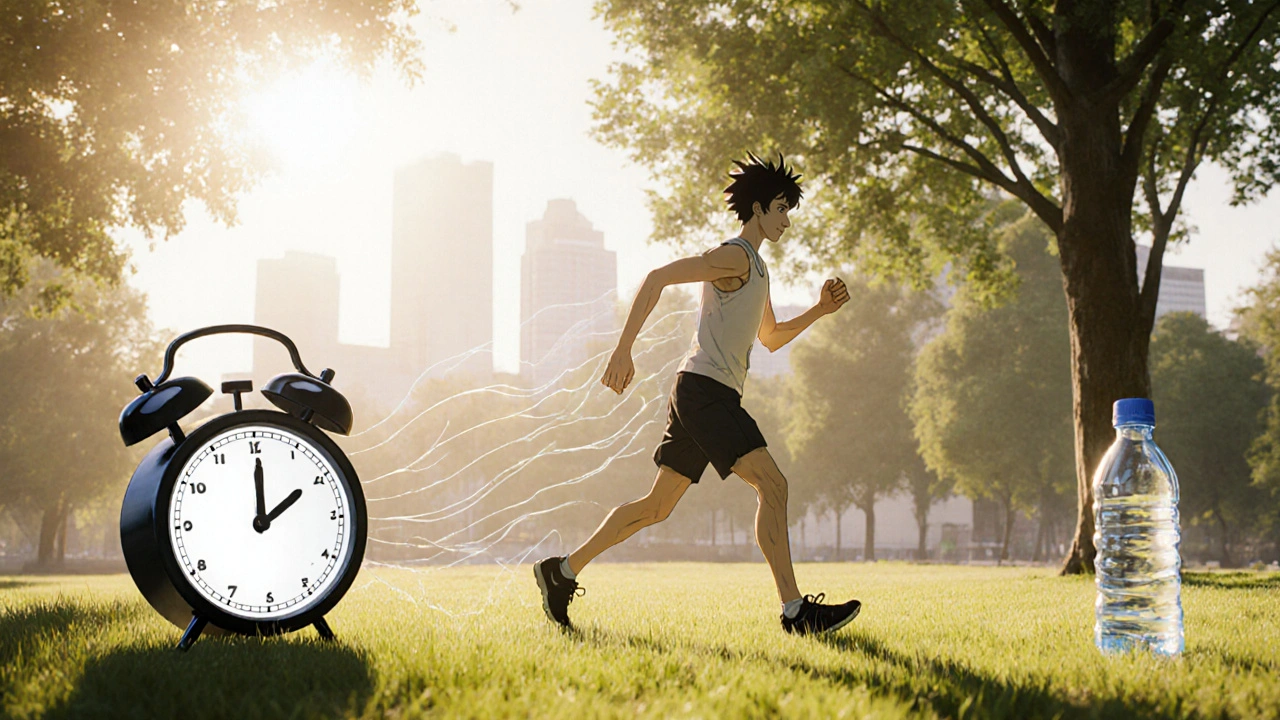Calcium & Vitamin D Intake Calculator
Alendronate Nutrition Calculator
Calculate your daily calcium and vitamin D intake from bone-healthy foods. This tool helps you avoid timing conflicts with Alendronate medication.
Add Your Foods
Add Your Foods
Your Daily Intake
Calcium: 0 mg
Vitamin D: 0 IU
Alendronate Timing Check
Avoid these foods immediately after taking Alendronate
Consuming these foods within 30 minutes of your dose may reduce Alendronate effectiveness by up to 60%:
- Milk and dairy products
- Fortified juices
- Calcium supplements
- Antacids
Safe to consume after Alendronate
These foods can be enjoyed 2-3 hours after taking your medication:
- Fortified soy milk
- Salmon with bones
- Almonds and chia seeds
When you’re prescribed Alendronate - a bisphosphonate medication that slows bone loss and helps treat osteoporosis, you’ll hear a lot about timing and diet. The drug works best when your body has the right building blocks - mainly calcium, vitamin D, and a few other minerals - but the way you eat can also help or hinder absorption.
Why diet matters while taking Alendronate
Alendronate sticks to bone tissue and tells the cells that break bone down (osteoclasts) to slow their activity. But it’s a picky pill: it can’t be chewed, and it hates sharing the stomach with calcium or iron. If you pop it with a glass of milk, you’ll cut its effectiveness in half. That’s why doctors tell you to take the tablet with plain water, wait at least 30 minutes, and stay upright for an hour.
The good news? The right foods, eaten at the right time, can give your skeleton the extra support it needs while the medication does its job. Think of it as a teamwork scenario - Alendronate handles the “stop the demolition crew” part, and your diet supplies the “building materials” for new bone.
Key nutrients for bone health
Four nutrients show up again and again in the research on osteoporosis:
- Calcium - the main mineral that makes up the bone matrix. Adults need about 1,000 mg daily, and that climbs to 1,200 mg after age 50.
- Vitamin D - the hormone‑like vitamin that tells your gut to pull calcium from food. Sunlight gives you most of it, but diet and supplements fill the gaps.
- Magnesium - works alongside calcium in the bone remodeling process and helps keep vitamin D levels steady.
- Protein - provides the framework for bone tissue. Aim for 0.8-1 g per kilogram of body weight each day.
Top bone‑friendly foods (and when to eat them)
Below is a quick cheat sheet of foods that pack a punch of the nutrients above. The trick is to keep them away from the Alendronate dose window but include them throughout the day.
| Food | Key Nutrient | Amount per serving | % Daily Value* |
|---|---|---|---|
| Low‑fat milk (1 cup) | Calcium | 300 mg | 30 % |
| Fortified soy milk (1 cup) | Calcium & Vitamin D | 350 mg / 120 IU | 35 % / 30 % |
| Cooked kale (1 cup) | Calcium & Magnesium | 180 mg / 30 mg | 18 % / 7 % |
| Almonds (¼ cup) | Calcium & Magnesium | 100 mg / 80 mg | 10 % / 20 % |
| Salmon with bones (3 oz) | Calcium & Vitamin D | 180 mg / 450 IU | 18 % / 56 % |
| Chia seeds (2 tbsp) | Calcium & Magnesium | 180 mg / 95 mg | 18 % / 24 % |
| Greek yogurt (½ cup) | Calcium & Protein | 200 mg / 12 g | 20 % / 24 % |
*Based on a 2,000‑calorie diet. Values vary by brand and preparation.
Timing your meals around Alendronate
Here’s a simple schedule that keeps the pill happy and still lets you enjoy bone‑boosting foods:
- Wake up, sip a full glass (8 oz) of plain water.
- Take your Alendronate tablet with that water - no juice, coffee, or milk.
- Stay upright (stand or sit) for at least 60 minutes. This reduces esophageal irritation.
- During this hour, you can read, stretch, or walk around the house.
- After the hour, enjoy a calcium‑rich breakfast like fortified soy milk with oatmeal, or Greek yogurt with berries.
- Space other calcium‑heavy meals (lunch and dinner) at least 2‑3 hours after the dose.
- That way you still hit your daily target without compromising drug absorption.
Sample day of eating with Alendronate
Below is a realistic menu that hits the recommended nutrient levels without clashing with the medication window.
- Morning (after 1‑hour wait): Oatmeal cooked in fortified soy milk, topped with sliced almonds and a drizzle of honey.
- Mid‑morning snack: A small apple and 10 g of cheddar cheese.
- Lunch: Kale and quinoa salad with grilled salmon (bones left in), tossed in olive‑oil‑lemon dressing.
- Afternoon snack: Greek yogurt mixed with chia seeds and fresh berries.
- Dinner: Stir‑fried broccoli, bok choy, and tofu served over brown rice; a side of calcium‑fortified orange juice (if you need extra vitamin D, a short 10‑minute walk in midday sun helps).
That plan supplies roughly 1,100 mg calcium, 800 IU vitamin D, 400 mg magnesium, and 70 g protein - all within the range suggested for adults over 50.

Common pitfalls and how to avoid them
Even with the best intentions, a few habits can sabotage the benefits of Alendronate.
- Taking the pill with calcium‑rich drinks. Milk, fortified juice, or even antacid tablets contain calcium that binds to the drug.
- Eating right after the dose. A snack within 30 minutes can lower absorption by up to 60 %.
- Relying on coffee or soft drinks. Caffeine and phosphoric acid increase urinary calcium loss.
- Skipping vitamin D. Without enough vitamin D, calcium from food isn’t absorbed well, and bone density suffers.
- Ignoring posture. Lying down too soon can cause esophageal irritation, which some people mistake for heartburn.
To keep things smooth, set a daily alarm titled “Alendronate - water only”. Keep your water bottle on the nightstand so you can take the pill first thing in the morning. Then, plan your calcium‑rich meals for later in the day.
Beyond food: lifestyle tweaks that work with Alendronate
Bone health isn’t just about what’s on the plate.
- Weight‑bearing exercise. Walking, dancing, or light resistance training 3‑4 times a week stimulates bone formation.
- Sunlight exposure. About 10‑15 minutes of midday sun on the arms and face 2‑3 times a week provides 600-800 IU vitamin D for most people in temperate zones.
- Limit alcohol. More than two drinks a day can increase fracture risk.
- Avoid smoking. Tobacco interferes with calcium absorption and harms bone cells.
When you combine these habits with a well‑timed diet, Alendronate can do its job more effectively, and you’ll see better bone density scores over time.
Quick checklist before you finish the article
- Take alendronate with a full glass of water on an empty stomach.
- Wait at least 30 minutes before eating or drinking anything besides water.
- Plan calcium‑rich foods for later meals, not the first hour after the pill.
- Include vitamin D sources - sunlight, fortified foods, or a supplement if needed.
- Stay upright for an hour and avoid lying down right after the dose.
- Incorporate weight‑bearing activity a few times a week.
Can I take calcium supplements with Alendronate?
No. Calcium binds to Alendronate and stops it from being absorbed. If you need a supplement, take it at least 2 hours after the pill.

Is it okay to take Alendronate with my morning coffee?
Avoid coffee for at least 30 minutes after the dose. Caffeine can irritate the esophagus and also interferes with calcium metabolism.
How much vitamin D do I need while on Alendronate?
Most adults benefit from 800-1,000 IU daily. If you have limited sun exposure, a supplement is often recommended by doctors.
What foods should I avoid right after taking Alendronate?
Skip dairy, fortified juices, orange juice, antacids, and any mineral supplement for at least 30 minutes. Plain water is the only safe companion.
Can I take Alendronate on an empty stomach if I feel nauseous?
Feeling queasy is common the first few weeks. Stay upright, drink water, and talk to your doctor about a short‑term anti‑nausea plan. Do not add food to the dose window.

